See below for books about libraries and librarians, animals at the library (including the real-life tale of Dewey the Library Cat), library mysteries, library poems, library projects, and a handful of really strange libraries…
Table of Contents
LIBRARY TALES
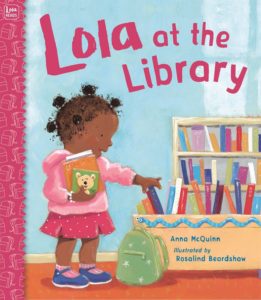
|
In Anna McQuinn’s Lola at the Library (Charlesbridge Publishing, 2006), Lola – who sports adorable pigtails – loves Tuesdays, when she and her mother visit the library. The book follows Lola through the day, ending with new library books and a story at bedtime. For ages 2-5. |
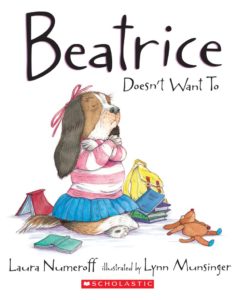
|
In Laura Numeroff’s Beatrice Doesn’t Want To (Candlewick, 2008), Beatrice’s big brother Henry has to write a school report on dinosaurs – but he also has to babysit for Beatrice. He ends up taking Beatrice with him to the library, with Beatrice protesting (“I don’t want to!”) every step of the way. Finally, in spite of herself, Beatrice becomes entranced by a library story time and Henry, when he comes to retrieve her, finds her happily curled up in a chair, lost in a book. For ages 3-6. |
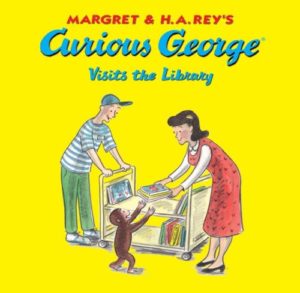
|
In Margret and H.A. Rey’s Curious George Visits the Library (Houghton Mifflin, 2003), the Man in the Yellow Hat takes George to story hour – where the disaster-prone little monkey gets twitchy (he wants to read a dinosaur book) and chaos ensues. All ends happily, however, with new books and George’s own library card. For ages 3-7. |
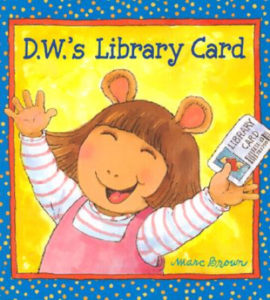
|
In Marc Brown’s D.W.’s Library Card (Little, Brown Books for Young Readers, 2003), Arthur’s little sister struggles to learn to write her full name so that she can get a library card in order to check out the book she’s been craving, Hop-a-Long Frog. A nicely done story (who doesn’t love Arthur and D.W.?) but I kept thinking “Why all this name-writing stuff? Just give the kid a library card!” For ages 3-7. |
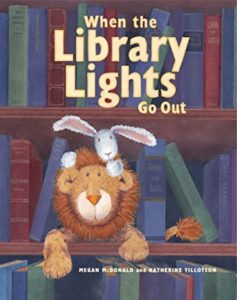
|
There’s an endless appeal to stories about what goes on after dark in the department store, toy store, dollhouse – and library. In Megan MacDonald’s When the Library Lights Go Out (Atheneum Books for Young Readers, 2009), the library puppets, Lion, Rabbit, and Hermit Crab, have a wonderful and imaginative moonlight adventure that ends with a picnic under the stars. A fun pick for library pajama parties. For ages 3-7. |
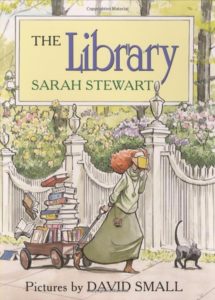
|
Sarah Stewart’s rhyming picture book The Library (Farrar, Straus & Giroux, 1995) is the story of young Elizabeth Brown, bookworm, who didn’t like to play with dolls and didn’t like to skate – all she liked to do was read. Finally she accumulates so many books that there’s simply no more room: “Volumes climbed the parlor walls/And blocked the big front door/She had to face the awful fact/She could not have one more.” It’s a problem with which many of us can sympathize. Elizabeth’s solution is perfect: she donates her books to the town and turns her house into a library. For ages 4-8. |
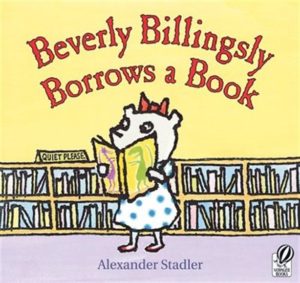
|
In Alexander Stadler’s Beverly Billingsly Borrows a Book (Sandpiper, 2006), Beverly, a panic-stricken small bear, has so adored her chosen library book (Dinosaurs of the Cretaceous Period) that she’s kept it too long and the book is now overdue. Friends have told her that she owes a thousand dollars in library fines and that she might end up in jail. Beverly is too upset to eat; she even has a nightmare in which the book’s due date – APRIL 7 – appears printed in red all over her pajamas. Finally she breaks down and confides in her mother; the book is safely returned; and the kindly librarian puts Beverly’s fears to rest. For ages 4-8. |
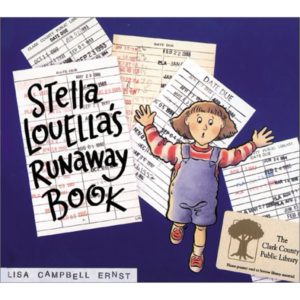
|
In Lisa Campbell Ernst’s Stella Louella’s Runaway Book (Simon & Schuster Books for Young Readers, 2001), Stella’s library book (“due today by five o’clock”) is missing and Stella is in a tizzy. There follows a frantic cumulative search, beginning with her brother Sam, who left it on the porch by the mailbox, and variously pulling in the mailman, a neighbor, a policeman, the owner of the town diner, an entire scout troop, and more, until finally the book turns up – safely back in the hands of Mrs. Graham, the librarian. For ages 4-8. |
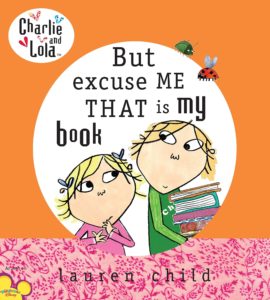
|
In Lauren Child’s But Excuse Me That is My Book (Dial, 2006), the irrepressible Lola is convinced that Beetles, Bugs, and Butterflies is the best book in the world. In fact, it’s the only book that she will check out of the library. When the beloved book is not on the shelves – and Lola sees another little girl walking out with it – big brother Charlie has to explain how libraries work: the books are there to be borrowed and shared. Eventually he even manages to convince Lola to try a new book – Cheetahs and Chimpanzees. For ages 4-7. |
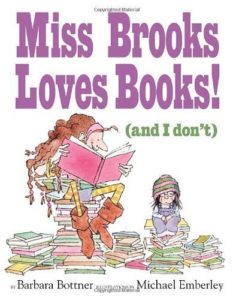
|
In Barbara Bottner’s Miss Brooks Loves Books (and I Don’t) (Knopf Books for Young Readers, 2010), Missy – a ragamuffin first-grader with an evil glare, in overalls and a woolly hat – can’t abide librarian Miss Brooks, who dresses up like book characters and does her best to find every child a perfect book. Missy rejects them all: fairies are too flowery, dogs too furry, trains too clickety. (“You’re as stubborn as a wart,” Missy’s frustrated mother says.) But finally the imaginative Miss Brooks does find Missy’s perfect book: William Steig’s Shrek, the story of a stubborn, smelly, snorty, green ogre, with warts. A hoot for ages 4-8. |

|
In Mike Thaler’s The Librarian from the Black Lagoon (Cartwheel Books, 2008), Hubie’s class is off to visit the library – rumored to be a dreadful place, presided over by the fearsome librarian Mrs. Beamster. There’s said to be a Gum Detector at the door; kids are glued to the chairs to keep them from wiggling; all the books are bolted to the shelves, and anybody who whispers gets laminated. Luckily this isn’t the case. For ages 4-8. |
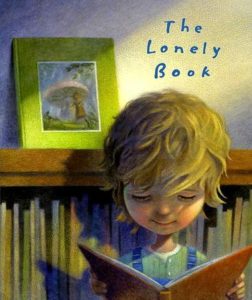
|
Kate Bertheimer’s The Lonely Book (Schwartz & Wade, 2012) is essentially The Velveteen Rabbit for books. When the book first arrives at the library, brand new, it is loved by all – but over time it grows worn and tattered; its last page is missing; and no one checks it out anymore. Relegated to the basement, the book languishes – until finally a little girl discovers it and is enchanted. For ages 4-8. |
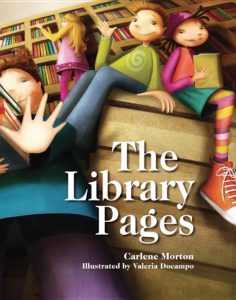
|
Carlene Morton’s The Library Pages (Upstart Books, 2010) is every librarian’s nightmare. Mrs. Heath, the school librarian, is out on maternity leave, but helpful kids send updates about how they’re keeping the library running smoothly: shelving the books by color, mending them with duct tape, and cutting up the encyclopedias for collages. Before Mrs. Heath totally melts down, it turns out to be an April Fool’s joke. For ages 4-9. |
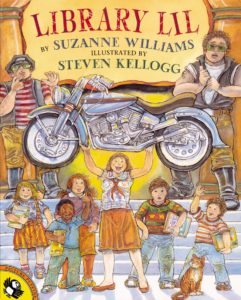
|
Suzanne Williams’s Library Lil (Puffin, 2001) – zanily illustrated by Steven Kellogg – is a library-style anti-TV tall tale starring Lil, Chesterfield’s stupendously strong and wholly unconventional librarian. When a storm blows down the Chesterfield television lines, Lil singlehandedly pushes the bookmobile from house to house, converting an entire town of TV-watching couch potatoes into voracious bookworms. Even a book-hating motorcycle gang is no match for Lil; by the end of the story, the leader of the gang, hooked on books, has become Lil’s library assistant. For ages 4-9. |
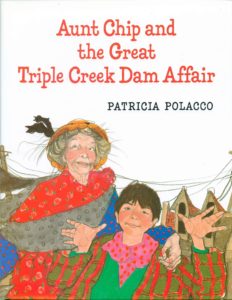
|
In Patricia Polacco’s Aunt Chip and the Great Triple Creek Dam Affair (Philomel Books, 1996), the people of Triple Creek erected an enormous television tower fifty years ago, and have since become so addicted to television that they have forgotten how to read. Books, now useless, are used to patch roofs, fill potholes, and mend walls. Then feisty Aunt Chip, once the town librarian, teaches her nephew Eli how to read – and soon all the kids in town are reading everything they can lay their hands on. Finally Eli and friends yank a copy of Moby Dick out of a hole in the town dam, which unleashes a flood, topples the TV tower, and brings the adults to their senses. By the end of the book, Aunt Chip has her old job back and reading reigns supreme. For ages 4-9. |
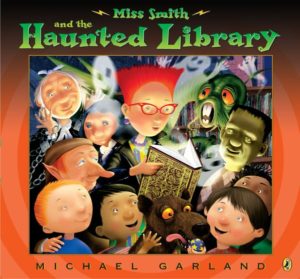
|
When Michael Garland’s red-headed teacher Miss Smith reads from her Incredible Storybook, the book characters come alive. In Miss Smith and the Haunted Library (Puffin, 2012), the class visits the library, presided over by purple-haired librarian Virginia Creeper, who uses the Storybook to conjure up such spooky characters as Frankenstein, Dracula, Captain Hook, the Hound of the Baskervilles, and the Headless Horseman. For ages 5-8. |
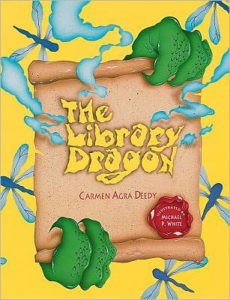
|
In Carmen Agra Deedy’s The Library Dragon (Peachtree Publishers, 2012), the librarian, Miss Lotty Scales, is an actual fire-breathing dragon – and a nasty one at that; she can’t stand the thought of children pawing at the books with their sticky little fingers, and so refuses to let anyone take a book from the shelves. Finally, nearsighted little Molly Brickmeyer – who has lost her glasses – wanders into the library, bumps into a shelf, and catches the book that falls into her hands. As she begins to read aloud, children eagerly gather round, and Miss Lotty has a change of heart. For ages 6-10. |
| Also see the sequel, Return of the Library Dragon (Peachtree Publishers, 2012), in which Miss Lotty’s dragonish nature re-surfaces when the library’s books are replaced with computers and e-readers. | |
| From the ALA’s Association for Library Service to Children, Fun activities @ your library has library-based games and scavenger hunts, and Reader’s Theater versions of The Library Card, The Chicken and the Librarian, and The Library Dragon. | |
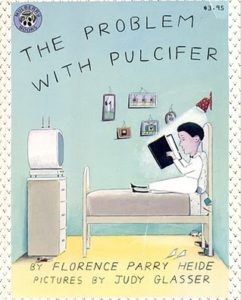
|
In Florence Parry Heide’s The Problem with Pulcifer (Mulberry Books, 1992), Pulcifer is an avid reader in a society dedicated to watching TV, and Pulcifer’s parents are concerned. (“It isn’t because we haven’t set a good example,” said Pulcifer’s mother. “We’re always watching television. And we’ve always had the nicest television sets. We’ve tried to make it easy for him. Color, remote, even TV dinners.”) At school, Pulcifer is put in a remedial class for non-television-watchers; eventually his parents even send him to a psychiatrist. Pulcifer, however, holds his own, and finally his parents learn that they love him even though he is different. At the end, Pulcifer happily settles down with a stack of new library books. For ages 7-11. |
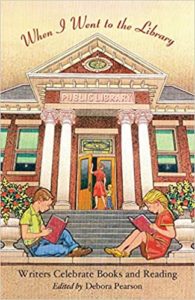
|
When I Went to the Library (Groundwood Books, 2002), edited by Debora Pearson, is a wonderful collection of short stories by nine noted writers about the ability of libraries to create adventures, liberate the imagination, solve problems, and change lives. In Ken Roberts’s “Dear Mr. Winston,” for example – which reads like something by Dorothy Parker – Cara struggles to apologize for letting a snake loose in the library. In Marc Talbert’s “Books Don’t Cry,” Tad uses the library to help come to terms with the impending death of his grandmother; and in Paul Yee’s “Fly Away,” a young Chinese girl, Mei-ping, finds that the library helps her cope with the loneliness of living in an isolated town in Canada. For ages 8-12. |
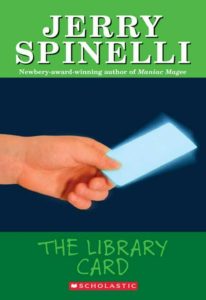
|
Jerry Spinelli’s The Library Card (Scholastic, 1998) is a tribute to the library’s power to help, heal, and change. The book tells the stories of four troubled kids and four library cards. Twelve-year-old Mongoose seems headed for a life of crime until he finds a library card in a stolen bag of candy and discovers a world of reading. Brenda is addicted to television until – bored to tears during her school’s Great TV Turn-Off week – she visits the library and discovers a mysterious and compelling biography of herself. Sonseray, an anti-social 13-year-old, finds comforting memories of his dead mother at the library that lead him to change his ways; and April, miserable about her family’s move to a mushroom farm in Pennsylvania, ends up on a high-jacked bookmobile, driven by the even unhappier runaway Nanette, with whom she forms a bond. For ages 9-13. |
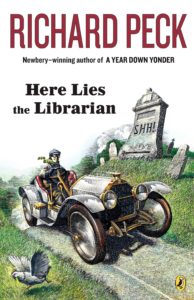
|
In Richard Peck’s Here Lies the Librarian (Puffin, 2007), set in rural Indiana in 1914, 14-year-old Peewee (Eleanor) McGrath is being raised by her older brother Jake; the two of them run a struggling small-town garage. Then the feisty Irene Ridpath arrives, fresh out of library school, along with her three sorority sisters, preparing to take over the defunct town library. For ages 10-14. |
